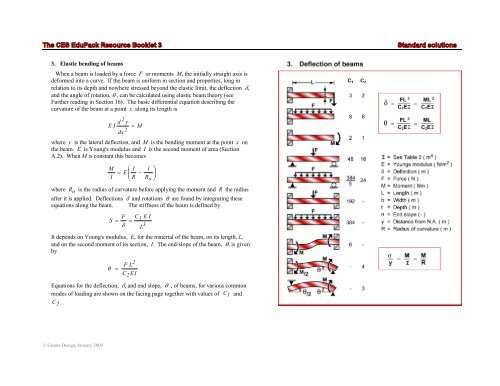Useful Approximate Solutions for Standard ... - MAELabs UCSD
Useful Approximate Solutions for Standard ... - MAELabs UCSD
Useful Approximate Solutions for Standard ... - MAELabs UCSD
Create successful ePaper yourself
Turn your PDF publications into a flip-book with our unique Google optimized e-Paper software.
3. Elastic bending of beams<br />
When a beam is loaded by a <strong>for</strong>ce F or moments M, the initially straight axis is<br />
de<strong>for</strong>med into a curve. If the beam is uni<strong>for</strong>m in section and properties, long in<br />
relation to its depth and nowhere stressed beyond the elastic limit, the deflection δ,<br />
and the angle of rotation, θ , can be calculated using elastic beam theory (see<br />
Further reading in Section 16). The basic differential equation describing the<br />
curvature of the beam at a point x along its length is<br />
© Granta Design, January 2009<br />
E I<br />
d<br />
2<br />
y<br />
= M<br />
dx<br />
2<br />
where y is the lateral deflection, and M is the bending moment at the point x on<br />
the beam. E is Young's modulus and I is the second moment of area (Section<br />
A.2). When M is constant this becomes<br />
M<br />
I<br />
⎛ 1<br />
= E ⎜<br />
⎝ R<br />
−<br />
1<br />
Ro<br />
where R o is the radius of curvature be<strong>for</strong>e applying the moment and R the radius<br />
after it is applied. Deflections δ and rotations θ are found by integrating these<br />
equations along the beam. The stiffness of the beam is defined by<br />
F<br />
S =<br />
= δ<br />
C1<br />
E I<br />
L<br />
3<br />
It depends on Young's modulus, E, <strong>for</strong> the material of the beam, on its length, L,<br />
and on the second moment of its section, I. The end-slope of the beam, θ, is given<br />
by<br />
F L<br />
2<br />
θ =<br />
C2<br />
EI<br />
Equations <strong>for</strong> the deflection, δ, and end slope, θ , of beams, <strong>for</strong> various common<br />
modes of loading are shown on the facing page together with values of C 1 and<br />
C 2 .<br />
⎞<br />
⎟<br />
⎠
















